Are you struggling with keeping your chest up and heels down when you squat? Are you limited on equipment or space? Do you wonder if you’re even doing it right in the first place? These are normal thoughts that will pop up from time to time, whether you’re a beginner or advanced gymgoer.
The kettlebell goblet squat is user-friendly, safe, and so effective at refining your technique that you’ll be scratching your head, wondering how in the world you hadn’t utilized it since your very first day in the weight room.
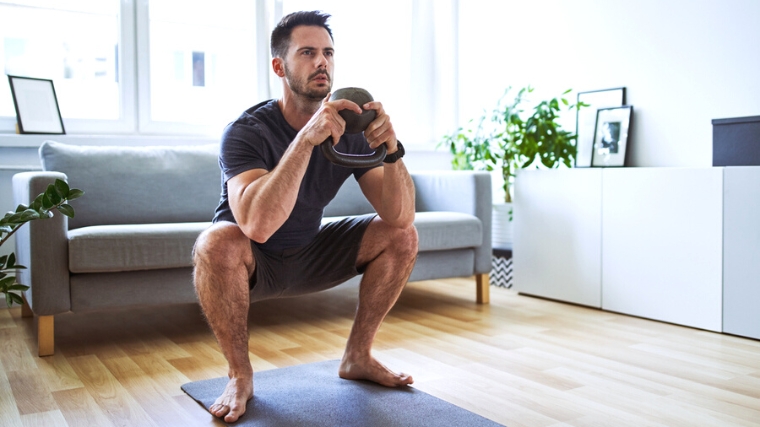
Follow along to learn more about how best to implement the kettlebell goblet squat into your training routine!
- How to Do the Kettlebell Goblet Squat
- Kettlebell Goblet Squat Sets and Reps
- Common Kettlebell Goblet Squat Mistakes
- Kettlebell Goblet Squat Variations
- Kettlebell Goblet Squat Alternatives
- Muscles Worked by the Kettlebell Goblet Squat
- Benefits of the Kettlebell Goblet Squat
- Who Should Do the Kettlebell Goblet Squat
- Frequently Asked Questions
Kettlebell Goblet Squat Video Guide
If you’re a visual learner, look no further than this step-by-step guide on how to perform the kettlebell goblet squat flawlessly:
For some additional information, or if you simply prefer to work through instructions on paper, the how-to below is all you’ll need.
How to Do the Kettlebell Goblet Squat
The beauty of this exercise is that it requires minimal equipment and you can do it almost anywhere. All you need is yourself, a kettlebell or dumbbell, and a flat surface to perform on. Here’s how to do the kettlebell goblet squat.
Step 1 — Establish Your Setup
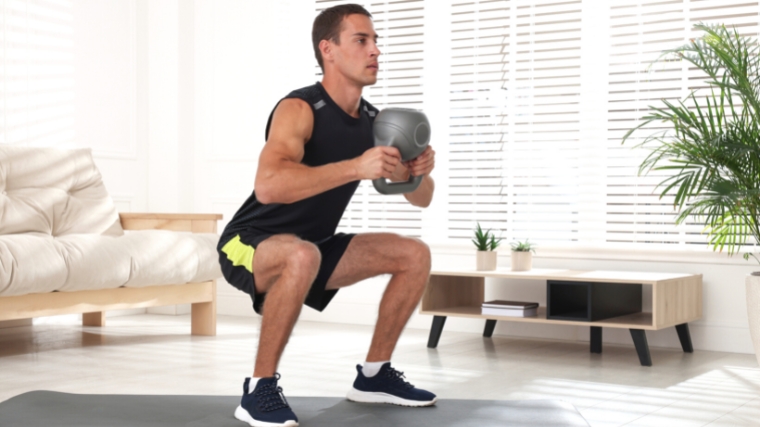
Position your feet within your normal squat stance (or place them shoulder-width apart with your toes pointed slightly outward). Next, pick up or swing the kettlebell up to your chest. Finally, grab the bell of the weight such that the bottom of the bell is pointed up while the horns of the handle are pointed down.
Coach’s Tip: Get into your squat stance while facing the kettlebell, then swing it into position.
Step 2 — Begin Your Descent
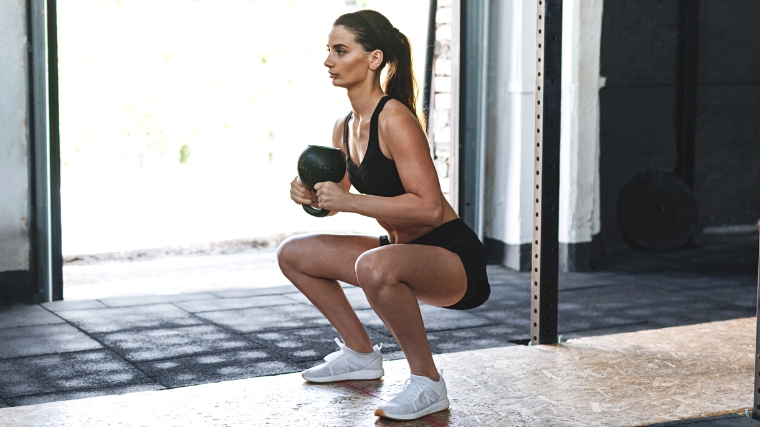
Take a big breath and feel the muscles surrounding your trunk get tight. Then, unlock your knees and hips at the same time. Allow your knees to naturally track over your toes while you’re supporting the kettlebell close to your body and sit straight downward into a squat.
Coach’s Tip: Keep the kettlebell close while dropping into the squat. Maintain tightness in your core the entire time.
Step 3 — Climb Out of the Hole
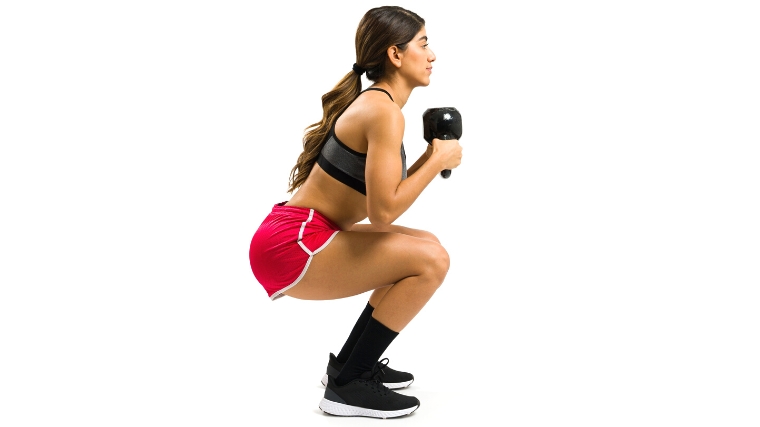
Reverse the motion once you reach the bottom of your mobility. Push out of the squat with your legs and maintain a tight core and upright torso the entire time.
Coach’s Tip: Imagine that you’re pushing the earth away from you with your legs.
Kettlebell Goblet Squat Sets and Reps
There are many different set and rep schemes that you can play around with for this exercise, but here are some general programming guidelines that you can follow depending on your goals.
- For Warming Up: Perform 1-3 sets of 6-12 reps, with 1-2 min rest between sets. Feel free to include pauses and slow eccentrics to warm up the working muscles using a lightweight to move through the range of motion.
- For Hypertrophy: Perform 3-5 sets of 8-12 reps; rest 90 to 120 seconds between sets. Leaving 2-3 reps in the tank with a challenging weight.
- For Strength: Perform 2-3 sets of 2-6 reps, with 2-3 minutes of rest between sets with a heavy, challenging weight.
Common Kettlebell Goblet Squat Mistakes
The kettlebell goblet squat may seem simple, but some common mistakes can still occur if you lose focus. Steer clear of these errors.
Not Holding the Weight Correctly
When executing the kettlebell goblet squat, you’ll want to hold the weight in front of you while keeping it as close to your body as you comfortably can.
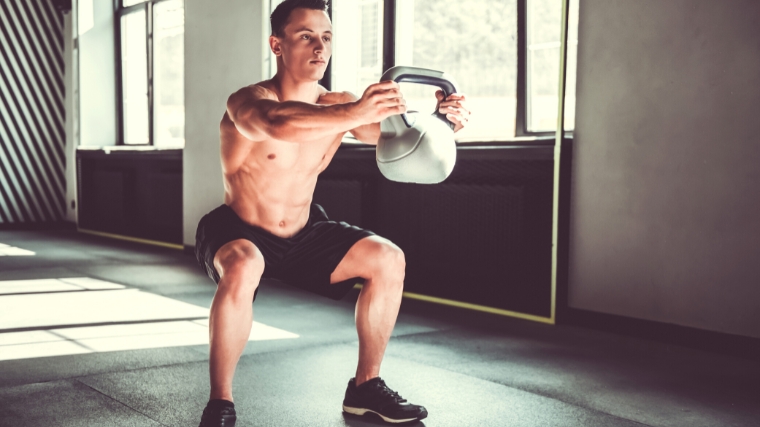
The further away the weight is from your center of mass, the harder the exercise will be, which can cause you to lose balance or apply too much stress to your upper body.
Relaxing at the Bottom
Be sure to maintain active engagement within your lower body muscles and not become too relaxed at the bottom of the squat by scooping your hips underneath you. This is called the “butt wink,” otherwise known as posteriorly tilting your pelvis. Excessively doing this may place unnecessary stress on the lumbar spine. (1)
Hips Rising Early
When you perform the kettlebell goblet squat, your chest and hips should raise at the same rate — you shouldn’t “tip over” as you stand up.
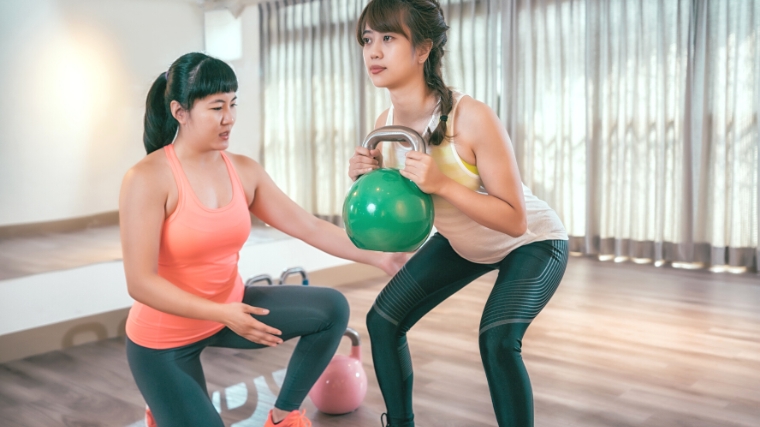
If you find yourself falling forwards, you probably aren’t placing as much emphasis on your quadriceps as you could be. It’ll also make each rep more challenging than it needs to be by reinforcing poor motor patterns.
Kettlebell Goblet Squat Variations
Doing the same exercise over and over can get boring. It’s essential to change the stimulus of the movement while keeping the fundamental spirit of the exercise alive to keep training fresh and fun while still getting the job done. Here are a few variations of the kettlebell goblet squat to challenge you in different ways.
Pause Kettlebell Goblet Squat
This variation is slightly different from the typical kettlebell goblet squat, as it includes a pause. The purpose of the pause is to build your confidence within the bottom position of the squat and to increase lower body flexibility and mobility.
Pauses also add some extra time under tension to the question as well, which can facilitate more muscle growth.
Goblet Cossack Squat
When you perform a standard squat (with a kettlebell or otherwise), your body moves in only one plane of motion (the sagittal plane). However, you should dedicate a portion of your training to moving laterally as well.
The goblet Cossack squat enables you to do just that. It’ll train side-to-side stability and challenge your core at the same time. You can also use it as a solid warm-up exercise.
Kettlebell Goblet Squat Alternatives
Even high-level powerlifters and Olympic-style weightlifters experience growing pains when building their squats. Sometimes you must take a step back to fill in those gaps before moving forward again.
If, for whatever reason, you don’t enjoy the kettlebell goblet squat, here are a few options that may suit you better.
Counterbalance Squat
This exercise is a great tool if you’re still new to squatting and don’t have your technique dialed in yet. By holding a light weight further out in front of you, you can familiarize yourself with the motor pattern of the squat.
Holding a weight at arm’s length provides a counterbalance, which improves your stability and helps you figure out how to move your lower body properly.
Heel-Elevated Goblet Squat
Suppose your ankle mobility is still holding you back. In that case, this is an excellent regression exercise to train the squat movement pattern while continuing to build muscular strength and size within your quadriceps.
You’ll want to place some type of wedge underneath your heel to elevate them about an inch high. Then, squat as usual. The elevated heel adjusts your center of gravity, and can make the squat feel more natural.
Dumbbell Front Squat
If holding a kettlebell in front of you during a squat is still too challenging (or you don’t have access to a kettlebell in the first place), don’t fret. You can use a pair of dumbbells instead and get just about the same result.
Holding two dumbbells aloft with one end resting on your shoulders will challenge your upper back and allow you to replicate the kettlebell goblet squat cleanly. Holding dumbbells in this front rack position is also a common requirement for CrossFit workouts.
Muscles Worked by the Kettlebell Goblet Squat
The better your understanding of what muscle groups are at play and how they behave during a squat, the faster you’ll be able to progress forward. Here are the major players of the kettlebell goblet squat.
Quadriceps
That large, beefy muscle on the front of your thigh is called your quadriceps. Your quadriceps are composed of four distinct compartments: the rectus femoris, the vastus lateralis, the vastus intermedius, and the vastus medialis.
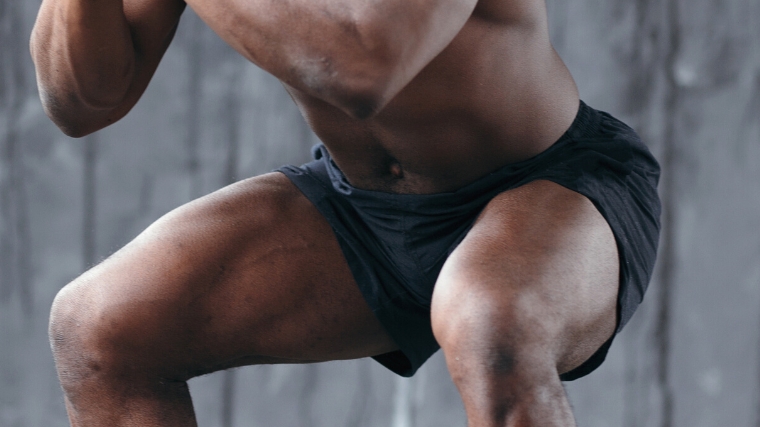
During the kettlebell goblet squat, your quads are the prime mover in helping you stand out of the bottom by extending your knees.
Glutes
Your glutes consist of the gluteus maximus, which produces most of your lower-body power, your glute medius, and glute minimus. The latter two muscles mostly contribute to rotating your leg in your hip socket.
Your glutes play an influential role in helping you stand up from a squatting position, particularly in the first half of the range of motion when they are in a stretched position. They also help you finish the exercise by bringing your body into hip extension.
Upper Back
Your back is made of many muscle groups and can be separated into separate sections. The upper section involves the trapezius, the latissimus dorsi, and the rotator cuff complex, while the lower section consists of the erector spinae.
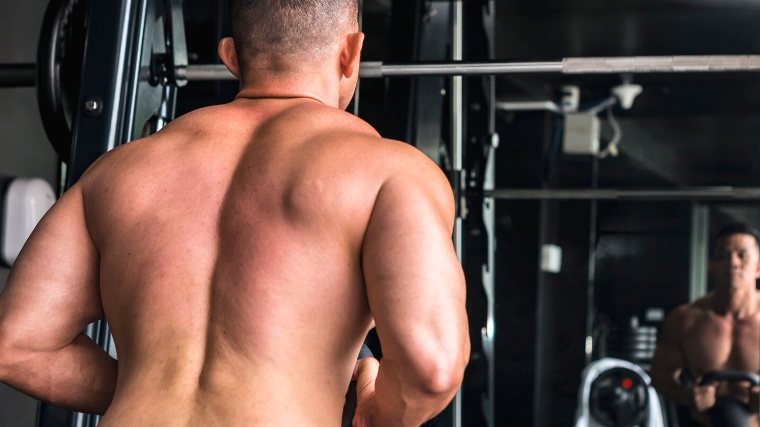
When performing a kettlebell goblet squat, your back contracts isometrically to hold the kettlebell up.
Abdominals
Your abdominal muscles consist of the rectus abdominis, internal and external obliques, and the muscles of your lower back as well. The kettlebell goblet squat is an anti-flexion exercise, meaning that the weight tries to force you to bend forward.
Your core works overtime to resist that forward pull and also maintain enough air in your abdomen to pressurize your torso like an inflated canister. You need this pressure to stay rigid while you move and protect your spine.
Benefits of the Kettlebell Goblet Squat
If you’re still not convinced that the kettlebell goblet squat is for you, here are a few benefits that may win you over.
More Leg Gains
Since the quadriceps are the primary muscle group targeted due to the amount of knee flexion. If the kettlebell goblet squat is inserted within your rotation, it’s almost impossible not to see some muscular growth in your legs.
More Mobility and Flexibility
Working with a kettlebell in the goblet position is considered anterior load; the weight is in front of your midline. Squatting with an anterior load helps you access deeper ranges of motion and challenges your mobility, since the resistance helps offset any balance issues you may have. In so doing, your mobility and flexibility will skyrocket. (2)
Extra Movement Security
Exercising with weight can be intimidating, especially if you’re a beginner. The last thing you want to do is get hurt before you even get started on your journey.
The kettlebell goblet squat requires you to hold one piece of equipment directly in your hands. You’ll have complete control over the exercise, and can drop the weight safely at any point to exit the movement. For rank beginners, working with an exercise like the kettlebell goblet squat can be much more encouraging than going straight for barbell squats.
They’re Accessible
You can do the kettlebell goblet squat just about anywhere — whether you’re working out of a busy gym, at home, or on the road.
All you will need is you and one kettlebell (or a similarly-sized object) with a flat surface to stand on. The kettlebell goblet squat is highly accessible to beginners and advanced athletes alike. Just pick up the weight and get to work.
Who Should Do the Kettlebell Goblet Squat
The beauty of the kettlebell goblet squat is that it can be beneficial to a multitude of individuals. Here are a few for you to keep in mind. If you fall into one of these categories, the kettlebell goblet squat is probably right for you.
Beginners
If you’re still building your squat technique, the kettlebell goblet squat can be an excellent option to dabble in. It’s a great regression tool to help drill correct squatting mechanics and build confidence in the required positions, all without compromising safety.
CrossFitters
You’ll very commonly see CrossFit workouts programmed with goblet exercises, including the kettlebell goblet squat. The more practice with and exposure to the exercise you can get, the better prepared you’ll be for your next WOD.
Weightlifters
A vital aspect of Olympic lifting is having a strong, low, and stable squat. Weightlifting is also a barbell-exclusive sport. Therefore, working with a kettlebell instead can be a great way to introduce variety into your programming.
You can also use the kettlebell goblet squat to warm up your legs prior to a heavy weightlifting session, or as part of an accessory training circuit.
Grab Life by the Bells
Whether you’re a beginner working on building, good sound squatting technique, at a busy gym in need of an effective leg exercise to do while all the squat racks are taken, or you’re on the road and want to pull over to do some squats to wake up your legs, the kettlebell goblet squat fits the bill.
It’s so user-friendly, safe, and effective, that it’s a no-brainer inclusion in most workout programs. If you’ve made it this far, it belongs in yours, too.
FAQs
It’s totally normal to have questions; here are a few questions about the kettlebell goblet squat that may or may not have popped into your mind while reading.
What is the purpose of the kettlebell goblet squat?
If you’re trying to work on your squatting technique, build more confidence at the bottom of a squat, and get more giant legs, the kettlebell goblet squat is for you. It’s an all-purpose squatting movement that is easy to learn.
How much weight should I do on the kettlebell goblet squat?
It depends on why you are performing the kettlebell goblet squat and what you want to get out of the exercise. Refer to the “Reps and Sets” section for different approaches and goals. No matter the plan, the weight should always be something you can control and utilize with good form.
References
- Nielsen, S. R. (2015). Posterior Pelvic Tilt in Barbell Back Squats. Brage NIH. Retrieved February 5, 2023.
- Alizadeh, S., Daneshjoo, A., Zahiri, A., Anvar, S. H., Goudini, R., Hicks, J. P., Konrad, A., & Behm, D. G. (2023, January 09). Resistance Training Induces Improvements in Range of Motion: A Systematic Review and Meta-Analysis. Sports Medicine.